Puppy-proof your garden – 7 practical tips that really work – and 3 to avoid!
If you’re going to puppy-proof your garden, there’s lots of advice out there. Not all of it works.
As a journalist, I start every project with the assumption that I know nothing and must question everything.
I talk to experts, read books and look up scientific research on the internet.
And not everything I found about how to puppy-proof your garden made sense. And some of it focused on the less important issues rather than the main risks to your puppy.
So now that our new puppy has tested the tips, I can tell you which worked and which didn’t. Some of the tips that don’t work for me may work for you, however.
And we’ve also discovered aspects of puppy-proofing a garden that seem barely mentioned – so we’ll go over those too.
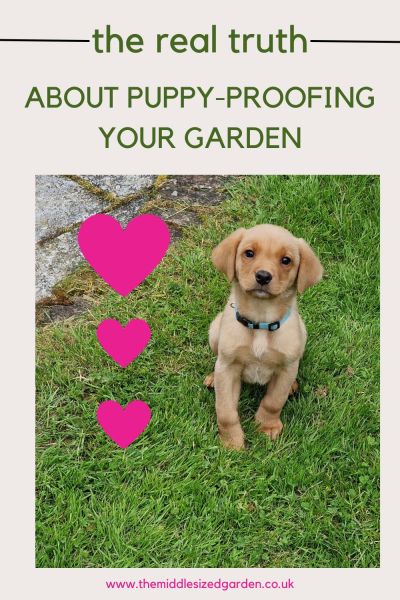
This is Ozzie at 9 weeks old. We’ve learned lots about how to puppy-proof your garden since he arrived.
How to puppy-proof your garden
- Check your boundaries – puppies can wriggle through very small gaps
- Store garden, garage and swimming pool chemicals safely out of reach
- Tidy away broken or breakable items, such as crocks
- Know which plants are poisonous – you won’t be able to keep your garden free of poisonous plants so supervise your puppy in the garden
- Chocolate is the most common cause of dog poisoning so avoid using cocoa mulch
- Prevent unsupervised access to ponds and mini-ponds
- Protect the bird feeder – don’t let your puppy eat fallen bird seed
- Puppies may eat slugs & snails so include lungworm prevention in worming treatments
Puppy-proof your garden No 1 – check your boundaries!
When a young puppy first arrives in a new home, he or she will follow his new family around everywhere. It takes a few weeks before they’re brave enough to explore.
But when they do explore, they can get through some very small holes in the fence or hedge. Even a gap cut for a hedgehog is an open gate for a small puppy.
Our previous adult dog was able to wriggle under a very small gap in the garden gate to escape. A puppy would have no problem! So check the space under gates and doors.
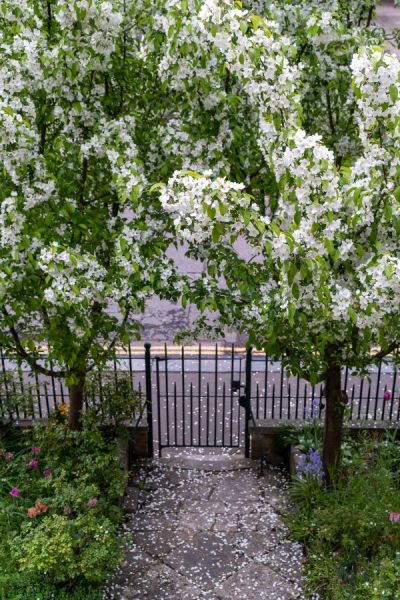
Our large adult dog, Lottie, could wriggle under this gate. So a puppy could escape easily. Check the smallest of exit points.
Store household, garden, garage and swimming pool chemicals safely
Most ‘how to puppy-proof your garden’ advice seems to focus on poisonous plants.
However, research by Direct Line Pet Insurance discovered that only 4% of vets report poisonous plants as an issue.
The Direct Line survey went on to list vet reports of chocolate, grapes, medications, household chemicals and onions as more common than poisoning by plants.
Household chemicals include garden products and things like anti-freeze, which is very dangerous.
A good tidy-up should sort all these.
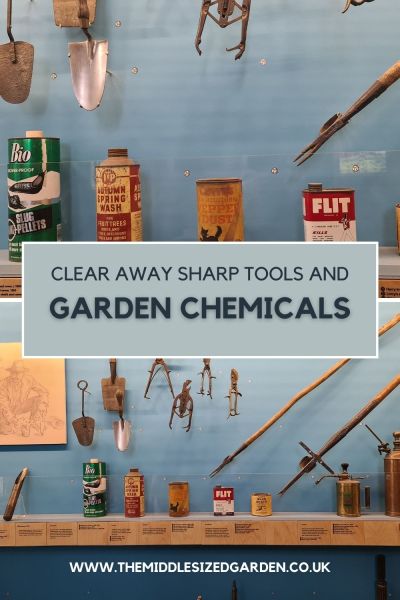
These are historic tools and garden chemicals in the Garden Museum in London. Most garden products are more pet-friendly today, but it’s still important to keep them out of reach.
So what about poisonous plants?
There are many lists of plants that are poisonous to dogs on the internet. That’s because so many plants are poisonous. Most ‘puppy-proof your garden’ lists include some, but not others – and it often seems a bit random.
A friend of mine who teaches horticulture reckons that about 20% of any garden will be toxic to both humans and pets.
However, chocolate is the biggest cause of poisoning in dogs. In the Direct Line Pet Insurance survey, 91% of vets reported chocolate poisoning. That is relevant to the garden, because it includes cocoa bean mulch, a by-product of chocolate manufacture. So avoid mulches containing cocoa bean hulls.
A list of plants that are toxic to dogs reads like a tour of my garden. Ivy, yew, box, anemone, buttercups, crocus, cyclamen, foxglove, lily of the valley, privet, snapdragons, verbena, dogwoods, rhubarb…that is just a small part of the list.
One puppy manual suggested that I either remove these (and dozens more varieties of plants) from the garden or ‘prevent the puppy from having access to them’.
This would require major re-landscaping. And no-one can guarantee that every single poisonous plant would be removed.
Plus when Ozzie grows up, he’ll encounter these plants in other people’s gardens, in parks and on walks. This advice is just not realistic.
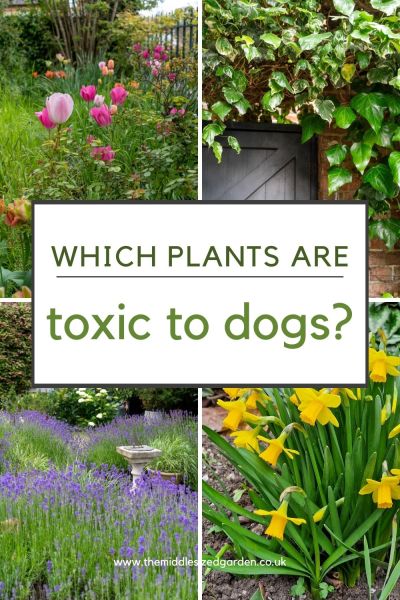
All these plants in my garden – tulips, ivy, lavender and daffodils – are toxic to dogs. It’s not realistic to take every toxic plant out. Some are just mildly irritant but others, such as oleander and foxglove, could be very dangerous if eaten. Find out as much as you can about which plants are toxic in your garden and supervise your puppy closely.
Poisonous plants – the practical solution
One of the most toxic plants for both humans and pets is oleander. I was in Sicily recently and there was oleander everywhere. There were also dogs and cats everywhere.
But there is no doubt that this issue is worrying. And there are no easy answers.
However, as I said earlier, only 4% of vets report plant poisoning as an issue. And neither of our adult dogs ever ate any poisonous plants.
Rather than remove toxic plants, we supervise the puppy closely in the garden. If he tries to eat anything, we take it out of his mouth and check it on the internet. His favourite game is to chase magnolia leaves. They are not toxic to dogs.
Some people put a pen in the garden so that the puppy can be outside safely, but we decided he would grow out of it too quickly.
I have noticed that he doesn’t seem to bother with many of the toxic plants. I saw him sniff yew and walk away. I saw the same with lavender. Both are toxic to dogs (though I did find one ‘puppy-proof your garden’ post suggesting you give your dog lavender twigs to chew…)
It may be that dogs have some instinctive awareness of poisonous plants. I wouldn’t wholly rely on it in puppies, though.
It’s also worth asking your vet if there are any local plants that have caused issues with dog poisoning.
Secure ponds and mini-ponds
Make sure your puppy can’t fall into a pond or mini-pond. Even a very small source of water can be dangerous to babies, toddlers, puppies and kittens.
Protect your pup from fallen bird food
None of the resources I looked at mentioned protecting the dog from the bird feeders and vice versa. Even if you use ‘no-mess’ bird food, birds toss grains of bird food down on the ground. Greedy dogs snaffle it all up.
Grain isn’t good for dogs. And it also means that they’re consuming too many calories. We’ve specifically chosen a grain free dog food.
We’re looking at ways of fencing off the area around the bird feeder so that Ozzie can’t access it. For now, we’ve temporarily stopped feeding the birds.
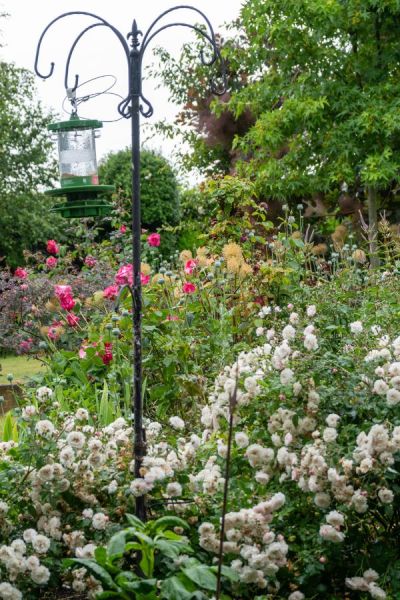
Puppies will eat fallen bird seed, so protect the ground around bird feeders. Ozzie can even wriggle in under the roses to find the bird food.
Gravel, snails and other unwelcome snacks
Once again, none of the resources mentioned puppies eating things like gravel and snails.
Ozzie eats tiny dark pieces of gravel because they look like his kibble (his dried dog food). We pick the stones out of his mouth. But there is no way we can remove every tiny stone from the garden.
I consulted our vet who said she’d operated on a dog with a whole stomach full of gravel. ‘He rattled when we placed him on the operating table.’ So just keep watching your pup.
Ozzie also loves to eat snails. Snails and slugs can transmit lungworm, which is extremely dangerous to dogs.
However, no-one has ever managed to get all the slugs and snails out of their garden either. And you wouldn’t want your pup to eat the chemicals that might be involved.
So make sure that his worming treatment includes anti-lungworm.
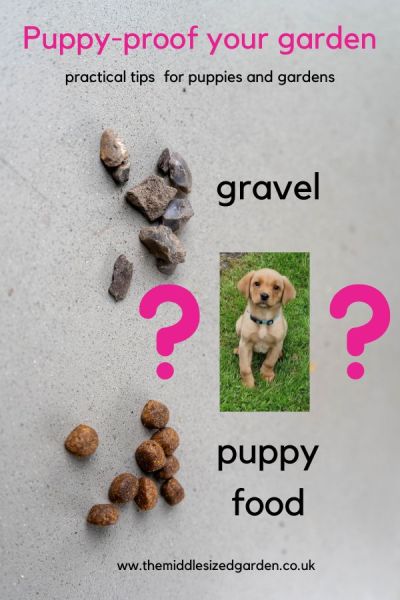
Ozzie thinks that small, dark pieces of gravel are his kibble.
Three ‘puppy-proof your garden’ tips to avoid!
Some of the ‘puppy-proof your garden’ tips I read seemed completely random. Did the people who wrote them have either gardens or dogs? But perhaps I am being unreasonable. Do correct me.
- ‘Don’t plant up to your boundaries’ I read this on a reputable and well-known website. The reasoning was that dogs check their boundaries regularly. So if you plant in front of your hedges, fences and walls, the dog will presumably trash your plants when it walks over them? I have visited hundreds of gardens. Most have borders in front of hedges, walls and fences. Most have dogs. Does this make sense? Or was it written by an SEO specialist just to add to their post on ‘how to puppy-proof your garden’? What do you think?
- ‘Plant sturdy plants like box.’ Once again, from a reputable source. Presumably a dog romping through your borders will smash plants. Once again, I know hundreds of gardens with dogs. Many have beautiful herbaceous borders without having to rely on ‘sturdy plants’. Staking and edging the borders protects them and many dogs can be trained not to go on borders. And, by the way, box is toxic to dogs.
- ‘Don’t have decking – it will splinter your dog’s paws’. If your decking is splintering your dog’s paws, it needs repairing or replacing. This post recommended gravel as an alternative dog-friendly garden surface. As Ozzie eats gravel, I would not agree. Natural grass is the best surface for dogs, but after that stone, concrete, decking or gravel will all have their pros and cons, depending on your lifestyle. If you’re thinking of artificial grass, you will need to buy products to ‘protect, cleanse and sanitise’ it from dog urine and faeces. Artificial grass is also the hottest surface when it’s in direct sun on very hot days. It can cause burns.
Pin to remember ‘puppy-proof your garden’ tips
And do join us. See here to receive a free weekly email with more gardening tips, ideas and inspiration.
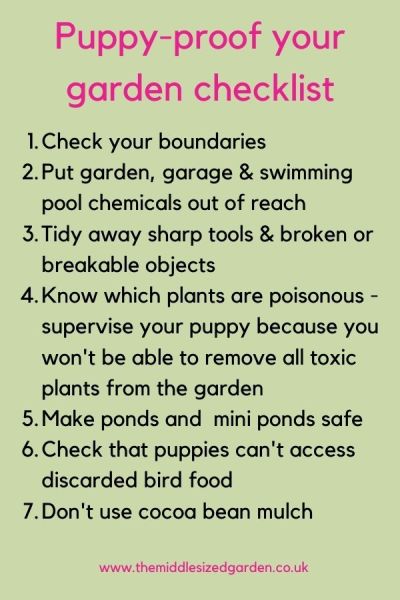
























Our puppy in the first year or two used to eat the plums that had fallen on the ground. Again, these are toxic to dogs. We fenced off the area only to realise she had found another source, this time over hanging branches from a neighbour’s garden! Although she would bring up bile, fortunately there was no lasting effect of eating the plum stones and she has now grown out of this habit!
I don’t know how they all survive, but luckily they seem to!
Thank you for the useful tips; we are orientating so we will be in order when the day comes. We would like to know what kind of dog Ozzie is? He looks too cute to be true;)
Thank you – I think he does look unrealistically cute rather like a puppy in an advertisement. He is a fox red labrador.
Early on you have to supervise but puppies learn quickly and training is key. Our dog knows that borders are off limits and has learned not to venture into them even when she hears our neighbour’s dog or chickens just the other side of the garden boundary.
We also use a product called ‘dog rocks’ in her drinking water which safely adjusts the PH or the dog’s urine and successfully prevents yellow patches on the lawn.
Thank you, good point.
Must mention Frogs, I have had 2 dogs that have picked up these and were quite unwell frothing and sick many times for about an hour afterwards, i managed to wash out the first dogs mouth which reduced the effect somewhat, but on the second dog which was a much smaller dog the frothing was much worse.
That’s a good point, thank you.
I have a dog and am well aware that chocolate is toxic to them. In about an hour, I am heading to our garden center with a friend to pick up mulch for our garden beds. I always admired the cocoa shell mulch and thought it would be fun to try it this year! Thankfully I read your blog post before making that mistake! My dim brain never made the connection there so thank you for saving me money and much more importantly, thank you for keeping my pup safe!
Thank you – and with all these things, I’m never quite sure exactly what quantity of cocoa mulch a dog would have to eat for it to be toxic. Just better being on the safeside.
I’ve had ten dogs in my life, and the only one who ate poisonous plants is my current cocker spaniel. We have lots of snowdrops and I,d pulled some up and put them on a table to replant elsewhere, and he put his paws up and ate, resulting in a trip to the vet for charcoal. He was six years old at the time! Snowdrop bulbs seem to come to the surface, so I’m very wary of them. We put wire or plastic netting on the bottom of our boundary fences and hedges and the gate. Your Ozzie is beautiful , happy days.
Interesting! I had wondered whether bulbs might be particularly alluring because they look like something a dog might play with.
Good tips. We’ve tried them all. Our dog goes for wooden stakes, makes brown patches on lawn and rolls in fox and bird poo. Still, we get a lot of pleasure out of both the garden and the dog!
Us, too! It’s worth the effort, though the puppy phase is somewhat alarming.